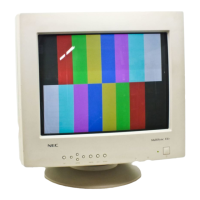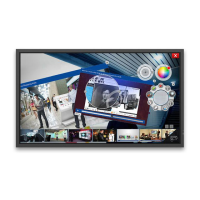Do you have a question about the NEC MultiSync XV29 Plus and is the answer not in the manual?
Precautions to prevent electric shock and fire hazards.
Instructions to prevent unit damage and prolong its operating life.
Specifies the duration of the warranty for parts and labor.
Outlines what is covered and not covered by the warranty.
Provides instructions on how to get warranty service for the product.
Details limitations on implied warranties and exclusions of damages.
Explains how state law relates to the warranty terms.
Introduces the MultiSync XV29 Plus monitor and its features.
Identifies and describes the controls and indicators on the front panel.
Details the various input/output terminals located on the rear panel.
Explains how to turn the monitor on/off and select video sources.
Describes how to access and navigate the On-Screen Manager (OSM) menus.
Details controls for adjusting image size, position, and shape.
Explains controls for adjusting brightness, contrast, color, and sound.
Instructions for installing and replacing batteries in the remote control.
Important warnings and advice for using the remote control unit.
Specifies the effective range and conditions for remote control operation.
Explains the purpose and general use of the DIP switches.
Details how Pin 1 controls synchronization settings for input signals.
Explains how Pin 2 enables or disables remote control operation.
Describes how Pin 3 controls access to the OSM system control menu.
Details the function of Pin 4 for power saving modes.
Illustrates the signal cable connections for various devices.
Guides on connecting computers via RGB cable for display.
Instructions for connecting VCRs or laser disc players via video/audio cables.
How to connect a document camera for video display.
Details the pin assignments and signal types for the D-Sub 15-pin connector.
How to turn the monitor on and off and its standby states.
Using front panel and remote buttons for basic adjustments.
How and when to use the degauss function to correct color impurities.
Navigating and using the On-Screen Manager (OSM) for adjustments.
Adjusting raster, visual, and sound settings via direct remote keys.
Adjusting brightness, contrast, sharpness, color, and tint.
Adjusting horizontal position, size, and image curvature.
Adjusting vertical position, size, and linearity of the display.
Controls for image rotation, tilt, keystone, and scan mode.
Adjusting white balance for RGB input signals.
Setting the position and auto-off time for OSM menus.
Provides technical data on current resolution and frequencies.
Controls for adjusting the audio volume of the monitor.
Procedures for resetting raster and visual settings to factory presets.
Configures the monitor's default input when powered on.
Enables or disables front panel buttons for security or preference.
Allows selection of the display language for menus.
Sets the standard for video input signals (NTSC, PAL, SECAM).
Toggles the availability of the OSM control features.
Solutions for when the monitor displays no picture or sound.
Troubleshooting steps for poor video quality with video signals.
Troubleshooting steps for poor video quality with RGB signals.
Solutions for audio issues when the picture is fine.
Addresses issues with sound from external speakers or stereo systems.
Diagnosing and fixing problems with the remote control not working.
Explains the meaning of a blinking power/standby indicator.
Details about the CRT display, including size and deflection.
Technical data for RGB and Video input terminals.
Details on audio input, monitor output, and sound output.
Information on display colors and synchronization signal ranges.
Maximum resolution and video bandwidth capabilities of the monitor.
Dimensions, weight, operating conditions, and regulations.
Illustrates timing characteristics for separate and composite sync signals.
Details timing for composite sync and sync on green video signals.
Specifies recommended timing parameters for sync signals.
Timing data for VGA and XGA-2 compatible resolutions.
Timing data for Macintosh and compatible graphics standards.
Timing specifications for VESA standard resolutions.
Timing specifications for MAC, 8514/A, and XGA standards.
Identifies signals and presets for Modes 1 through 4.
Identifies signals and presets for Modes 5 through 7.
Details NEC's policy for on-site service and repair.
Defines the policy for products that fail upon initial receipt.
Outlines the process for returning products for exchange or repair.
| Refresh Rate | 75 Hz |
|---|---|
| Aspect Ratio | 21:9 |
| Resolution | 2560 x 1080 |
| Screen Size | 29 inches |
| Input Connectors | VGA |
| Connectivity | VGA |












